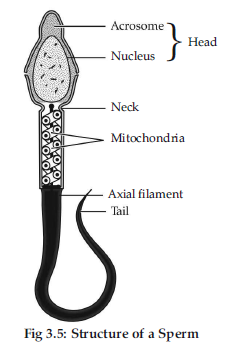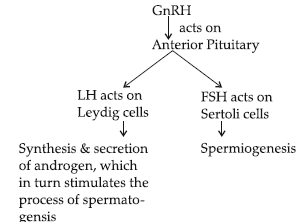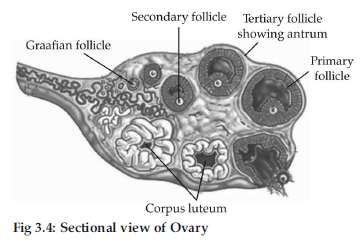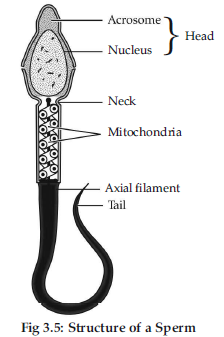VBQs Human Reproduction Class 12 Biology with solutions has been provided below for standard students. We have provided chapter wise VBQ for Class 12 Biology with solutions. The following Human Reproduction Class 12 Biology value based questions with answers will come in your exams. Students should understand the concepts and learn the solved cased based VBQs provided below. This will help you to get better marks in class 12 examinations.
Human Reproduction VBQs Class 12 Biology
Very Short Answer Type Question
Question. Mention the difference between spermiogenesis and spermiation.
Answer : Spermiogenesis is the process of development of spermatozoan from spermatids, while spermiation is the maturation and releasing of sperms.
Spermiogenesis occurs over sertoli cells while during spermiation, the sperms detach from sertoli cells.
Question. How does the sperm penetrate through the zona pellucida in the human ovum ?
Answer : Acrosome present at the tip of the sperm helps to penetrate through the zona pellucida in human ovum.
Question. Write the function of each of the following :
(i) Luteinizing hormone in human males
(ii) Middle piece of human sperm.
Answer : (i) Luteinizing hormone (LH) stimulate leydig cell to secrete androgens which in turn stimulate spermatogenesis.
(ii) There are numerous mitochondria in the middle piece of sperms which produce energy which is required for the movement of sperms.
Question. Write the physiological reason, why a woman generally cannot conceive a child after 50 years of age ?
Answer : In human beings, menstrual cycle ceases around at 50 years of age and there will be no production of egg. It is the phase in a woman’s life when menopause occurs, ovulation and menstruation stop. Hence, a woman cannot conceive a child after 50 years of age.
Short Answer Type Question
Question. Name the stage of human embryo at which it gets implanted. Explain the process of implantation.
Answer : The embryo gets implanted at blastocyst stage.
The trophoblast gets attached to the endometrium uterine wall of mother by a process called implantation and the inner mass of cells gets differentiated as embryo. After attachment the uterine cells divide rapidly and cover the blastocyst.
As a result the blastocyst gets embedded in the endometrium of the uterus.
Question. Enumerate the events in the ovary of a human female during :
(i) Follicular phase,
(ii) Luteal phase of menstrual cycle.
Answer : (i) Follicular phase : Follicular phase is also called the proliferative phase. During the phase, the FSH released by the pituitary stimulates the growth of the primary ovarian follicles and also causes maturation of the primary oocyte in this follicle. The follicular cells of the Graafian follicle secrete estrogen.
Due to an increased level of estrogen the uterine endometrium becomes thick, more vascular and more glandular. This phase lasts for about 10 to 14 days or until ovulation occurs.
(ii) Luteal phase : Development of corpus luteum, secretion of progesterone.
Question. Mention the relationship between concentration of luteinising hormone and maintenance of endometrium in the human uterus.
Answer : (Mid cycle) LH surge → formation of corpus luteum → progesterone, maintain the growth of endometrium.
Question. Explain the events in a normal woman during her menstrual cycle on the following days :
(i) Ovarian event from 13-15 days
(ii) Ovarian hormones level from 16 to 23 days
(ii) Uterine events from 24 to 29 days.
Answer : (i) Rupture of Graafian follicle leads to ovulation/ release of ovum.
(ii) Estrogen level is low.
(iii) Disintegration of endometrium and menstrual cycle begins again.
Question. Draw a diagram of human sperm. Label only those parts along with their functions that assist the sperm to reach and gain entry into the female gamete.
Answer :

Functions :
(i) Acrosome : Filled with enzymes that help enter the ovum.
(ii) Mitochondria (middle piece) : Energy source for movement of sperm to reach ovum.
(iii) Tail : For motility.
Question. Explain the hormonal control of spermatogenesis in humans.
Answer : Spermatogenesis is under the control of endocrine hormones. In human male reproductive system, spermatogenesis starts at the age of puberty due to significant increase in the secretion of gonadotropin-releasing hormone by hypothalmus.
The increased level of GnRH then acts on the anterior pituitary gland and stimulates secretion of the two gonadotropins : Luteinising hormone (LH) and follicle stimulating hormone (FSH). LH acts on leydig cells and stimulates synthesis and secretion of androgens like testosterone which stimulates spermatogenesis. FSH acts on the sertoli cells and stimulates secretion of some factors which help in the process of spermiogenesis. Excess of testosterone inhibits the secretion of LH and GnRH. A glycoprotein called inhibin suppresses FSH synthesis. Thus normal release of testosterone is under negative feed back control.

Long Answer Type Questions
Question. (i) Briefly explain the events of fertilization and implantation in an adult human female.
(ii) Comment on the role of placenta as an endocrine gland.
Answer : (i) (a) On the 14th day of menstrual cycle, ovulation takes place which releases secondary oocyte.
(b) This secondary oocyte is caught by fimbriae and it starts moving up the fallopian tube.
(c) In the meantime, sperms which have been deposited in vagina start moving up and reach the fallopian tube.
(d) The two meet at ampullary isthmus junction and fuse together.
(e) After entry of sperm secondary oocyte completes its meiosis II, changes the ovum and fuse with sperm’s pronuclei leading to zygote formation.
(f) This zygote after sometime starts dividing.
It changes to morula (8-16 celled), which continues to divide to form the blastocyst. The morula moves further into the uterus.
(g) The cells in the blastocyst are arranged into an outer trophoblast and an inner cell mass.
(h) The trophoblast gets attached to the uterine endometrium and the process is called implantation. This leads to pregnancy. The inner cell mass gets differentiated to form the embryo.
(ii) Placenta as endocrine gland produces :
(a) hCG (Human Chorionic Gonadotropin)
(b) hPL (Human Placental Lactogen)
(c) Oestrogen
(d) Progesterone
(e) In the later stages of pregnancy, it also releases relaxin. These hormones support foetal growth and help in maintaining pregnancy.
Question. Explain the process of spermatogenesis in humans.
Answer : Spermatogenesis is the formation of sperm in seminiferous tubules of testis. It has two stages :
(i) Formation of Spermatids
(ii) Spermiogenesis.
In the formation of spermatids, the sperm mother cells or Spermatogonia produce spermatids and in spermiogenesis, the spermatids are transformed into sperms or spermatozoan. At the time of sexual maturity, the primary germ cells divide mitotically to form a large number of spermatogonia which later on grow in size and form primary spermatocytes. The primary spermatocyte undergo meiosis-I to produce small haploid secondary spermatocytes which divide by meiosis II to form spermatids. The spermatids under the influence FSH is metamorphosed into spermatozoa. The schematic representation of spermatogenesis is as follows :

Question. The graph given below shows the variation in the levels of ovarian hormones during various phases of menstrual cycle :

(i) Identify ‘A’ and ‘B’.
(ii) Specify the source of the hormone marked in the diagram.
(iii) Reason out : why A peaks before B.
(iv) Compare the role of A and B.
(v) Under which condition will the level of B continue to remain high on the 28th day?
Answer : (i) A–Estrogen
B–Progesterone
(ii) A–Maturing ovarian follicle/Graafian follicle
B–Corpus luteum
(iii) Formation of Graafian follicle (releases estrogen) is followed by the formation of corpus luteum (releases progesterone)
(iv) Role of A (Estrogen)—Leads to changes in the ovary and uterus/regeneration of endometrium through proliferation
Role of B (Progesterone)—Maintenance of endometrium for implantation of the fertilized ovum/ maintenance of other events of pregnancy
(v) In case of pregnancy.
Question. Given below is the diagram of a human ovum surrounded by a few sperms. Observe the diagram and answer the following questions :
(i) Compare the fate of sperms shown in the diagram.
(ii) What is the role of zona pellucida in this process ?
(iii) Analyze the changes occurring in the ovum during the process.
(iv) How is the entry of sperm into the ovum facilitated ?
(v) Specify the region of female reproductive system where the event represented in the diagram takes place.
Answer : (i) A is able to penetrate / fertilize the ovum, whereas B and C are unable to penetrate / fertilize // B and C will degenerate.
(ii) Zona pellucida ensures the entry of only one sperm into the ovum
(iii) Induces completion of meiotic division of the secondary oocyte, formation of second polar body and a haploid ovum
(iv) Enzymes of acrosome help (½ mark if only ‘acrosome‘ is written)
(v) Ampullary – isthmic junction of the fallopian tube
Question. Explain the process of development of a mature human female gamete from the time it is initiated till the formation of ootid.
Answer :

Detailed Answer :
Oogenesis is initiated in embryonic stage when millions of egg mother cells are formed within each ovary. Oogonia multiply to form primary oocytes which enter into prophase-I of the meiosis and get temporarily arrested at that stage. Each primary oocyte then get surrounded by a layer of granulosa cells and is called the primary follicle. A large number of these follicles degenerate before reaching puberty and the remaining ones get surrounded by more layers of granulosa cells and a new theca. These are now called secondary follicles. The secondary follicles are then converted into tertiry follicles that have characteristic fluid filled cavity called antrum. In this stage, the primary oocyte present within the tertiary follicle completes meiosis, which results in the formation of haploid secondary oocyte and a tiny polar body. This tertiary follicle further changes into the graafian follicle. The secondary
oocyte in the graafian follicle is surrounded by the zona pellucida. Then graafian follicle ruptures to release the ovum by ovulation.
Question. When and where are primary oocytes formed in a human female ? Trace the development of these oocytes till ovulation (in menstrual cycle). How do gonadotropins influence this developmental process ?
Answer : (i) The primary oocytes are formed in the foetal ovary during the development of the foetus. The ovum is formed by the process of oogenesis.
(ii) During embryonic growth, millions of gamete mother cells (oogonia) are formed in the foetal ovary. These cells undergo meiosis, but get temporarily arrested at prophase and are called primary oocytes. Before reaching puberty, a large number of primary oocytes degenerate and the remaining ones get surrounded by layers of granulosa cells and a new theca. These are called secondary follicles. The secondary follicles are then converted into tertiary follicles that have characteristic fluid-filled cavity called antrum. At this stage, the primary oocyte present within the tertiary follicle completes meiosis, which results in the formation of haploid secondary oocyte and a tiny polar body. This tertiary follicle further changes into the Graafian follicle. The secondary oocyte in the Graafian follicle is surrounded by the zona pellucida. Then, the Graafian follicle ruptures to release the ovum by ovulation.
(iii) Role of gonadotropins : The gonadotropins (Follicle Stimulating Hormone and the Luteinising Hormone) are released by the anterior portion of the pituitary gland. The maturation of the primary follicles into the Graafian follicles occurs during the follicular phase. The secretion of gonadotropins increases during this phase, cause follicular growth and the growing follicles produce oestrogen. The LH and FSH are at their peak in the middle of the cycle (14th day) and cause the rupture of the Graafian follicles to release ovum. This phase is called the ovulatory phase.
Question. (i) Write the specific location and the functions of the following cell in human male :
(a) Leydig cells
(b) Sertoli cells
(c) Primary spermatocyte
(ii) Explain the role of any two accessory glands in human male reproductive system.
Answer : (i) (a) Leydig cells :
(ii) Location : Outside seminiferous tubules / Interstitial space.
Function : Synthesize or secrete male hormones / Testicular hormones / Androgens.
(b) Sertoli cells :
(i) Location : Lined inside the seminiferous tubules.
Function : Provide nutrition to the germ cells / sperms.
(c) Primary spermatocytes found in the inner lining of seminiferous tubules. They undergo meiosis and form sperms.
(ii) The accessory glands are seminal vesicle, prostate gland, bulbourethral gland.
Secretion of these glands constitute seminal plasma which is rich in fructose, calcium and certain enzymes provide nourishment to sperms, secretion of bulbourethral glands also help in lubrication of penis.
Question. (i) Draw a diagram of a sectional view of human ovary and label
(i) Primary follicle;
(ii) Tertiary follicle;
(iii) Graafian follicle and;
(iv) Corpus luteum.
(ii) Write the function of corpus luteum.
Answer : (i)

(ii) Corpus luteum secretes progesterone, which is essential for maintenance of endometrium.
Question. (a) Explain menstrual cycle in human females.
(b) How can the scientific understanding of the menstrual cycle of human females help us a contraceptive measure ?
Answer : (a) (i) Menstrual Phase : Menstrual flow occurs / due to breakdown of endometrial lining of uterus, when fertilization does not occur.
(ii) Follicular Phase : Primary follicles grow into mature graafian follicles and endomentrium regenerates through proliferation, changes induced by pituitary and ovarian hormones.
(iii) Ovulatory Phase : LH surge, induces rupture of graafian follicle and release of secondary oocyte /ovum during middle of cycle (i.e. 14th day).
(iv) Luteal phase : Ruptured graafian follicle transforms into corpus luteum which secrete large amount of progesterone, essential for maintaining endometrium.
(b) Because ovulation occurs during mid cycle chances of fertilization are very high so, couples should abstain from coitus between day 10 – 17.
Question. Draw a human sperm and label acrosome and middle piece. Mention their functions.
OR
Draw the microscopic structure of human sperm and relate its different parts with their functions.
Answer :

Functions of parts :
(i) Plasma membrane—envelops the whole body of sperm.
(ii) Acrosome—filled with enzymes that help in fertilization of the ovum.
(iii) Middle piece—Contains numerous mitochondria which produce energy for the movement of tail.
(iv) Tail—facilitates sperm motility, essential for fertilization.
(v) Mitochondria—produce energy.
(vi) Nucleus—Carries haploid set(n) of genes.